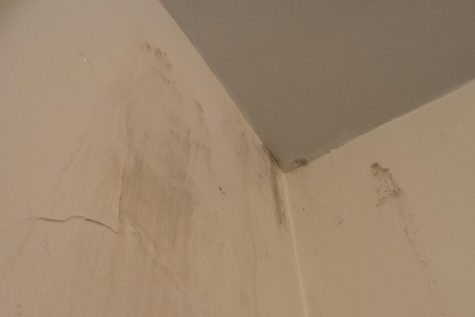Lindenwood responds to students’ concerns about mold
April 21, 2023
Senior Sammy Strieker moved out of her dormitory two years ago during her sophomore year because of the mold that was growing in her room in Ayres Hall.
Strieker complained about the mold in her room to her area coordinator and maintenance but nothing was done to fix the issue. With time, it started to have an impact on her health.
“In my original room, there was some sort of mold in the ceiling. It was giving me some breathing issues and making me kind of sick so I reported it to my area coordinator,” Strieker said. “The only option they had was to move and it never got reported further for fixing. So I decided to switch rooms to not have health issues anymore.”
Strieker and her roommates called campus maintenance when they started having problems with their ceiling, but the issue was not fixed so Strieker decided to move out.
“My roommates and I originally called maintenance when our ceiling was leaking and almost falling,” Strieker said. “After that, there wasn’t any word from maintenance about anything. My area coordinator said she was going to be in contact with them but I’m unsure of what happened after I moved out.”
Sophomore Sophie Juliana said she has the same problem in her bathroom this year in Irwin Hall.
“It grows super quick in the bathroom seemingly no matter what we do. We keep the window open, the fan on and the door open for good ventilation,” Juliana said. “You would think that this could help prevent the mold, but it doesn’t.”

Senior Vice President of Operations Diane Moore explained how mold is most likely to grow in bathrooms and how to remove it.
“What happens in that building is that you take a (hot) shower, look I love my hot showers, I love them to death, but when you go out of the bathroom and close the door, all of that heat and everything doesn’t have any place to go so it goes into the wall. And it’s going to create what you see striking down the walls,” Moore said. “It’s surface, what you do is you use bleach and you wipe it down.”
Juliana said she has been experiencing health issues since moving into the room. She is not sure yet if the mold is the reason but she has some suspicions.
“I wake up with a sore throat and I can’t help but wonder if it’s due to the mold,” Juliana said. “I know my roommate feels the same, frustrated that we can’t figure out how to deal with it as well as how it can affect us.”
Associate Professor of Biology Chad Welsh explained how mold, also known as fungi, develops in college dorms.
“Numerous molds or fungi are found in the average college dormitory and in our homes too,” Welsh said. “For the fungi to grow there must be a damp or moist environment such as in showers, around leaky windows, or an area where the humidity is not controlled.”
When Associate Vice President of Operations Tim Crutchley first arrived at Lindenwood, there were a lot of concerns as the school had issues controlling the humidity.
“When I got here there were a lot of concerns because of the problems of controlling the humidity,” Associate Vice President of Operations Tim Crutchley said. “If you can’t control the humidity, you can’t control mold growth sometimes.”
Strieker said the health issues she was experiencing because of the mold started to have big consequences on her life, so she took the decision to move out in order to protect her health.
“The big thing was that I was having trouble breathing. I would have to take Benadryl a lot more than I was comfortable with just so I could sleep at night and breathe,” Strieker said. “I also developed some congestion and a cough after a little while as well.”
Mold can become an issue if someone is exposed to it in the long term. Welsh explained how fungi impact the health of those who come into contact with them.
“The problem with exposure is that for the individual who is immunocompromised, low-level exposure could have clinical consequences, or when the exposure level is quite high, the fungi is growing in the walls or in the carpets. At this level of fungi exposure, even healthy individuals could have some clinical issues,” Walsh said. “To minimize this level of exposure, there will need to be some remodeling and removal of all contaminated materials.”
Welsh gave some tips to prevent mold from growing in bathrooms and rooms.
“The best thing to do, as a prevention method, is to reduce the time for drying in wet or damp areas such as the bathroom or shower rooms,” Welsh said. “There are some commercially available fungicides that are rather harsh chemicals and spray/use should be minimized when people are around.”
According to the Moldman website, here are the products people can buy for killing mold:
- Concrobium Mold Control: According to Concrobium, it helps eliminate and prevent mold with no bleach.
- RMR-86: According to Rmr Solutions, it is a spray cleaner that breaks apart tough stains.
- Clorox Clean Up: According to Home Depot, cleaner + bleach like Clorox Clean Up helps remove mold and disinfect without scrubbing.
- Benefect: According to Mold Advisor, it is a disinfectant that cleans and kills mold.
- bleach: According to professional house cleaner Sara San Angelo, “Bleach will kill mold spores growing across a hard surface.”
- white vinegar: According to San Angelo, “The vinegar will penetrate to kill the mold and mildew at the root, preventing it from regrowing.”
Lindenwood is aware of the situation and is doing what it can to make sure students live in a safe environment.
“The university has put millions of dollars into the facilities so that we could control mold and so that we can make sure that the buildings are safe,” Crutchley said.
Story updated on May 2, 2023. Comments from Senior Vice President of Operations Diane Moore and Associate Vice President of Operations Tim Crutchley were added to the original story.










